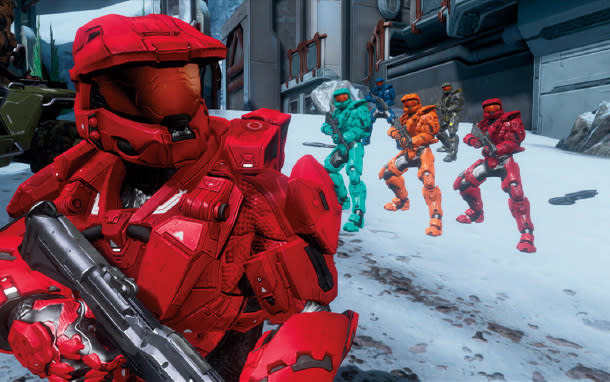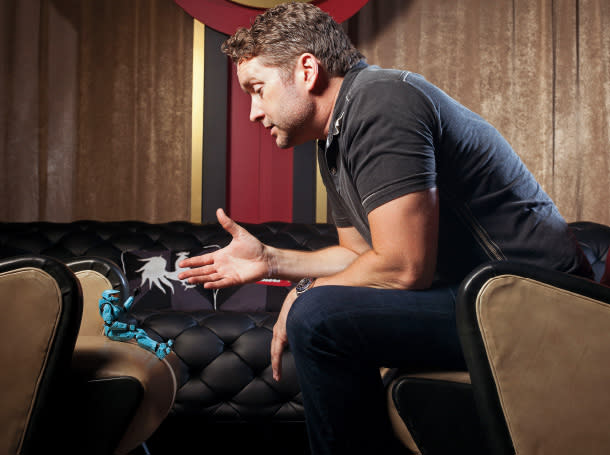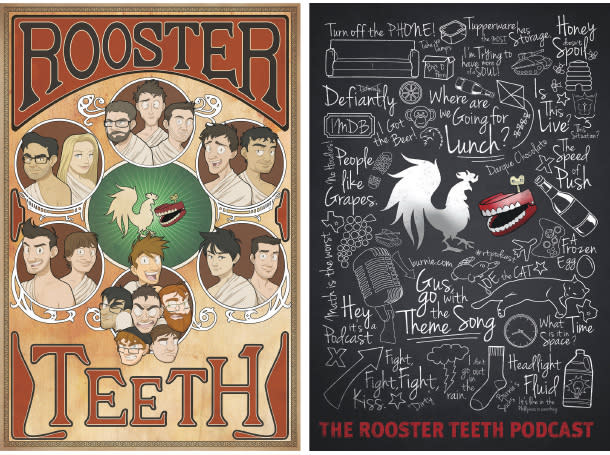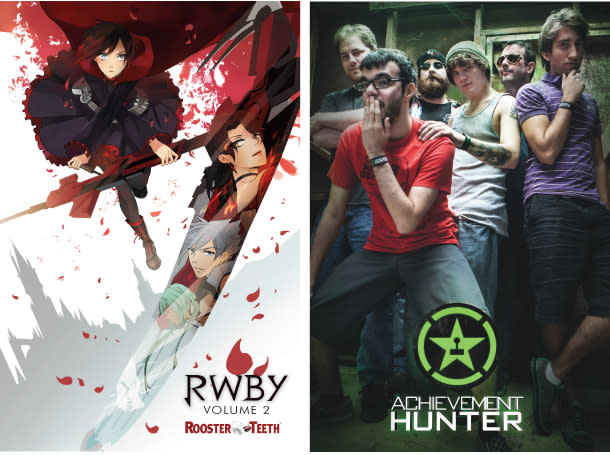Meet the Producers Behind Indiegogo's Highest-Funded Film
The longest-running science-fiction series in internet video history begins not with a bang but a whimper. Two gun-toting soldiers outfitted in futuristic armor stand guard over a desolate box canyon, defending their military base from the threat of enemy invasion.
“You ever wonder why we’re here?” the crimson soldier asks. “It’s one of life’s great mysteries, isn’t it?” yellow replies. “Why are we here? Are we the product of some cosmic coincidence, or is there really a god watching everything? You know, with a plan for us, and stuff?”
Silence. “What?!” the crimson soldier finally says, incredulous. “I mean, why are we out here? In this canyon? What’s all this stuff about god?” So it goes for another two minutes, eschewing all pretense of traditional sci-fi action in favor of existential farce and metatextual snark. And 12 seasons and 256 episodes later, it’s still going, with no end in sight.
Welcome to the delightfully oddball world of Red vs. Blue, the flagship franchise of Austin-based creative studio Rooster Teeth Productions, and a milestone in the evolution of “machinima” (a portmanteau of “machine” and “cinema”), a genre of animated films created via 3-D computer graphics engines. Since its online premiere in 2003, Red vs. Blue—a foul-mouthed satire of military bureaucracy rendered in the hyper-stylized visual grammar of first-person shooter video games—has emerged as an international cult sensation seemingly impervious to the whims of the mercurial web community, driving billions of online views and inspiring a deluge of licensed merchandise, including DVDs, T-shirts, posters and toys.

Snark tank: Rooster Teeth founders Matt Hullum (left) and Michael Burns.
Image credit: Ben Sklar
“The innovation with Red vs. Blue wasn’t just about the art form itself—it was using the art form as the basis to tell a story with a compelling narrative,” says Rooster Teeth co-founder and CEO Matt Hullum. “It’s very traditional in many senses. It has great characters and a good story you can follow. The format is almost irrelevant.”
Rooster Teeth has leveraged Red vs. Blue’s longevity to build an ever-expanding production slate of animated and live-action programs, including the anime-inspired RWBY, The Slow Mo Guys (a showcase for slow-motion videos), Achievement Hunter (a website and video channel devoted to gaming tutorials and demonstrations) and the Rooster Teeth Podcast (a weekly discussion of current projects and pop-culture trends). The company produces about 40 shows each week, feeding a Millennial fan base with an insatiable appetite for consuming media across multiple device screens.
Rooster Teeth is biting off its biggest creative challenge to date with Lazer Team, a feature-length, live-action film that at press time was scheduled to enter production in October. The studio opted to finance the project through crowdfunding website Indiegogo, and the rabid Rooster Teeth fan community stepped up in record fashion: Lazer Team outstripped its original $650,000 goal by a whopping 382 percent, raking in a grand total of $2.48 million over 30 days, becoming the highest-funded film in Indiegogo history.
“We have about 15 million subscribers across all of our YouTube channels, and we had 37,000 funders for the Lazer Team campaign,” says Rooster Teeth co-founder and creative director Michael “Burnie” Burns. “Thirty-seven thousand out of 15 million is a slim percentage. But those 37,000 are the people who cosplay [i.e., dress up] as our characters and go to sci-fi conventions. They’re hyper-engaged. Just by mobilizing even a small percentage of our audience—less than a tenth of a percent—we were able to break records.”
Hullum and Burns met as students at the University of Texas at Austin, producing programming for the school’s television station TSTV and later co-directing the 1997 independent feature The Schedule. The movie generated scant attention on the festival circuit, and while Hullum relocated to Hollywood to work as a visual-effects coordinator, Burns remained in Austin, signing on with customer-service company teleNetwork.
Burns earned his first taste of internet fame in 2000, when he teamed with teleNetwork colleagues Gus Sorola and Geoff Ramsey to launch DrunkGamers.com, reviewing video games while inebriated and producing video shorts that included a live-action parody of Apple’s “Switch” advertising campaign. The Apple clip went viral, catching Hullum’s attention and opening his eyes to the internet’s potential as a video distribution channel.
“What got us going in terms of starting a business was saying, ‘Remember how we did this in college? We made stuff and put it out directly to people. Now we can do that again, but on a global scale,’” he says.

Machinima v?rit?:A scene from Red vs. Blue.
Image credit: Rooster Teeth
Burns capitalized on the Apple video’s momentum by producing a trailer for Red vs. Blue, the saga of opposing groups of soldiers battling a civil war. Roughly six months later, he created the first episode in the space of a single weekend, recruiting Hullum, Sorola, Ramsey and actor Joel Heyman to record comedic dialogue over gameplay footage culled from game developer Bungie’s blockbuster first-person shooter Halo: Combat Evolved.
Unbeknownst to Burns, other pop-culture enthusiasts were already making films using gameplay videos from first-person shooter titles. The 1996 short Diary of a Camper, assembled using footage from id Software’s Quake, is widely credited with spawning the genre now known as machinima.
“Machinima is a different way to play video games,” Burns says. “A video game is a very advanced tool for displaying a 3-D world in real time, with interaction. The game is the thing the developers layer on at the last minute that tells you how to interact with that world. We decided, we’re not going to play your game—we’re going to play this game, where we walk around and lower the guns and explore the world.
“Machinima is also a super-efficient way to produce animation,” he adds.
“It doesn’t have the visual fidelity of something like a Pixar movie, but a Pixar movie has 300 to 500 people working on it for three years. We can produce five minutes of Red vs. Blue animation with three people.”
Rooster Teeth posted Red vs. Blue’s debut episode, “Why Are We Here?” on April Fool’s Day 2003. Within hours the video was linked on popular websites like Slashdot, Fark and Penny Arcade, and while downloads totaled only about 3,000, an unknown number of fans burned copies to CDs, passing them out to friends. The grassroots campaign vaulted Red vs. Blue’s second episode, posted the following Monday, past 250,000 downloads; by the end of the month, new episodes were averaging 1 million downloads each.
Just one problem: With video-sharing platforms like YouTube and Vimeo yet to be launched, Rooster Teeth leased server space to host Red vs. Blue, and as download activity exploded, the startup racked up $12,000 in fees within the first month alone. The bill prompted Rooster Teeth to roll out a premium program that’s still in place today, giving paying members exclusive access to new content before it’s offered to the general public, as well as rewards like exclusive videos and merchandise. Memberships range from $9 for three months to $60 for three years.

Image credit: Ben Sklar
Red vs. Blue’s popularity brought Rooster Teeth to the attention of Microsoft, which had acquired Bungie and its Halo franchise in 2000. “Microsoft—a company that understands the value of IP—should have said, ‘That’s cute, but stop.’ That’s the way the story probably should have ended,” Burns says. “But Microsoft said, ‘We’re a company that values innovation. This seems very innovative, and people like it. Let’s see where it goes.’ That turned into a couple months, then a couple years, and here we are, 12 years later, a fully licensed partner of the Halo franchise.”
Red vs. Blue is the second-longest-running web series in history, behind the Flash-animated cartoon Homestar Runner. Season 12 of Red vs. Blue premiered in April, and three months later, Rooster Teeth rereleased the first five seasons through streaming service Netflix. While Hullum and Burns continue voicing their Red vs. Blue characters, writing and production is handled mostly by a new generation of talent, many of whom came of age devouring the company’s content: About 30 percent of all hires originate from the Rooster Teeth fan community, Burns estimates.
Writer and director Miles Luna, who helmed Red vs. Blue seasons 11 and 12, relishes the opportunity to revitalize the franchise. “Burnie says we’re not making Red vs. Blue for the people who used to love it. We’re making it for the people who love it now,” Luna says. “We try to make a show that we’d want to watch. We believe that if you make something that you and your friends like, there’s bound to be other people that like it, too. We’ve stuck to that golden rule throughout the years, and it’s served the company really well.”
Rooster Teeth produces its shows at a 19,200-square-foot soundstage at Austin Studios, a 20-acre film and creative media facility on land that was once home to the Robert Mueller Municipal Airport, which closed in 1999.
Richard Linklater (the Austin auteur behind acclaimed films such as Dazed and Confused and this year’s Boyhood) and other local cinema luminaries convinced city officials to lease some of the hangars to Linklater’s nonprofit Austin Film Society. Today, Austin Studios encompasses two soundstages, a screening room, production offices and the largest cyclorama wall in Texas, stretching 87 feet.
Rooster Teeth relocated to Austin Studios this past spring after outgrowing its previous headquarters. “What makes Rooster Teeth so exciting and special for us is that they have a foot in traditional media and film, and a foot in new media,” says Rebecca Campbell, the Austin Film Society’s executive director. “We feel like they set the tone for us to stay cutting-edge and relevant as media evolves.”

Image credit: Rooster Teeth
Rooster Teeth’s Stage 5 site is a labyrinth of recording and editing equipment, stage sets and props and klieg lights. “Film is a very lease-based economy—you hire somebody who has a lighting package, for instance, and they come out with all their lights, and when you’re done, they take their lights with them,” Burns says, stepping inside a portable soundproof room where actors’ dialogue is taped. “We’re releasing content 365 days a year, so we wanted to get to the point where we own about 90 percent of the equipment we need, and rent the additional 10 percent. It makes us pretty watertight.”
Rooster Teeth’s DIY ethos is best exemplified by a 24-by-24-foot room lined with 24 motion-capture cameras, enabling staffers to digitally record human movements and map the data onto animated character models.
“This is how we’re able to produce so much animation so quickly and so cost-effectively,” Hullum says. “There are a lot of animation companies that use mo-cap but don’t have their own mo-cap facility, so you have to plan out all the stuff you hope to get, and if you don’t get everything right, you have to go back. For us, if a guy has an idea, he can hop up, walk right in here, and it’s done.”
Motion capture powers RWBY, the series created by Monty Oum, Rooster Teeth’s director of animation. RWBY, which follows four teenage girls battling to save the world of Remnant from evil supernatural forces, premiered in 2013 and attracted a dedicated following, especially among young female viewers.
Rooster Teeth recently inked a deal with Warner Bros. Home Entertainment Japan to redub RWBY for Japanese audiences, with the first season expected to roll out on Blu-ray and DVD in 2015. “It’s the first American-produced anime imported to Japan,” Oum says proudly. A RWBY game is also in development, signaling Rooster Teeth’s first foray into the gaming segment.
As Rooster Teeth’s creative output has evolved, its business model has followed suit. While the company does not share revenue numbers, executives credit sponsorship fees and sales of DVDs and T-shirts for keeping the lights on during the early years. As its profile grew, Rooster Teeth also created commercials for EA Sports, Ubisoft and other game publishers, but it did not incorporate advertising into Red vs. Blue until the show’s fifth season.
Ads are now a major component of Rooster Teeth’s revenue stream: In addition to pre-roll spots, some live-action series incorporate products from sponsors like Toyota and Kia. The product placements are faithful to Rooster Teeth’s core aesthetic; for example, a Slo Mo Guys episode sponsored by Dr Pepper depicts bottles of the soda shot with a crossbow and exploding in super slow motion.
“The reason we’ve been so successful in building brand loyalty is because we retain our credibility—we make sure all the content we create is relevant to our audience and respects the fact that we are first and foremost an entertainment company, not an advertising arm for any company we work with,” says Rooster Teeth director of business development Alan Abdine. “We’re not fooling anybody. Our fans know that Toyota and Dr Pepper gave us money. But because we’ve earned so much credibility, they watch our shows and go out and buy the product.”

Image credit: Rooster Teeth
Rooster Teeth is equally cautious about how, where and when its content is distributed. Although its primary YouTube channel boasts nearly 8 million subscribers and 3 billion views, ranking as the fourth-most-watched nonmusic channel worldwide, episodes are not posted to YouTube until they’ve appeared on Rooster Teeth’s own site.
“We get credit for having a progressive online business, but a lot of what we do is traditional, tried-and-true business tactics for distributing media,” Burns says. “We show content first on our website, then it goes out to home video, then our distribution partners, then on YouTube. Some of those windows are as long as a year. But I compare that to how traditional media is distributed—first it’s in theaters, then it goes to cable television, then it goes to network television. You have to stay adaptive, and when the environment changes, you have to embrace it. But all of our YouTube efforts still tell you, ‘You could have seen it first at RoosterTeeth.com.’”
How has Rooster Teeth managed to remain relevant for a dozen years in a web culture in which most viral sensations crash and burn in the blink of an eye? The company credits its symbiotic relationship with fans. In late 2004, Rooster Teeth unveiled a social networking website with a community forum, cast and crew journals and exclusive sponsor content. The site supports more than 1.7 million registered members and averages five forum posts per minute.
“Rooster Teeth has always been very transparent in showing you the people that are making these things,” says Kerry Shawcross, a writer and co-director on RWBY. “Everybody is in the limelight—they’re posting journals, so you’re reading their thoughts, and they’re doing podcasts, so you’re listening to them. You feel like you get to know them.”
The community interaction is not confined to the virtual world. Following years of fan-organized events across North America and abroad, in 2011 Rooster Teeth launched RTX, an annual gaming and internet convention in Austin complete with creator panels, developer exhibitors and meet-and-greets with online personalities. The first RTX welcomed 600 attendees; the 2014 iteration brought in 32,000, with guests paying $40 for a single-day admission or $80 for a three-day pass.
The faithful turned out yet again when Rooster Teeth opted to crowdfund the film Lazer Team, a sci-fi comedy about a secret government initiative to protect the Earth from alien invasion. The Indiegogo campaign offered a range of physical and digital perks including a Blu-ray or DVD package priced at $35 (purchased by more than 8,000 backers) and an on-screen executive producer credit, priced at $10,000 and purchased by 12 backers.
“People contributed because Lazer Team is something they want to see happen,” Hullum states. “They wanted to stake their claim and say, ‘I was there. I made it happen.’”
John Vaskis, Indiegogo’s senior director of outreach, says Rooster Teeth deserves praise for engaging with audiences throughout the campaign—for example, hosting a conference call with supporters and organizing a 12-hour weekend live stream that functioned as an online telethon.
“One of the biggest reasons we see campaigns not do well is that they’re kept very close to the vest,” Vaskis says. “You want to go out there before the campaign, share your ideas, get feedback and find out what people want to see from you. There are so many different ways to engage with fans, like Reddit [chats]. It’s all about mobilizing your audience.”
Rooster Teeth expects to release Lazer Team in spring 2015. Also in development are online projects including X-Ray and Vav, which Hullum calls “a goofy superhero show,” and a competitive pranks program, Social Disorder. Fans can rest assured that there are many more ideas where those came from.
“When Matt and I go to conventions or talk to people who are from big media companies, they all say the same thing: ‘This is still the first inning for [digital media],’” Burns says. “That’s amazing to us. We’ve been doing this for 12 years, we have 80 employees and a convention that brings in 30,000 people, but we’re all just getting started. Who knew we were in the on-deck circle this entire time?”

 Yahoo News
Yahoo News 
